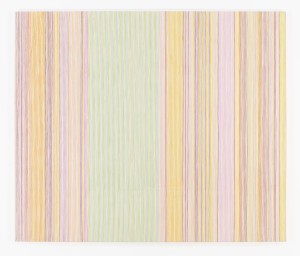2426 Main Street
Bridgehampton, NY 11932
T 631.537.7245
Linear Abstraction 101
June 1, 2016– July 1, 2016
-

Gene Davis (1920-1985) Untitled c. 1973 Acrylic on canvas 92 3/4 x 108 1/2 inches
Linear Abstraction 101
This year marks the 101st anniversary of a turning point in the history of visual art, when Russian artist Kazimir Malevich created his momentous 1915 paintings of black squares on white backgrounds. It was the beginning of an intense shake-up of artistic expression in the 20th century. As its title so aptly demonstrates, the show uses the concept of the line—or more specifically, the hard-edged line—as a starting point in exploring how contemporary artists approach abstraction. Obviously, lines are omnipresent in art—in fact, it would be hard to preclude artists from being in the show if the engagement of lines were the only criteria. This exhibition explores the use of the line throughout modern art. Including works by Frank Stella, Ken Noland, Gene Davis and Lucio Fontana.
Famous for saying of his artwork: “What you see is what you get.” The sentence became the mantra of minimalist artists of the 1960’s and established Stella as one of the pioneers of a new art movement that stressed the reduction of the image to its most basic elements of color, shape and design. Minimalists strove to create artwork that was devoid of symbolism, representation or opinion. However, the complexity of Stella’s work since the 1960’s casts a shadow of doubt over whether he was able to confine his subjects to the ideas he propagated. This artist’s love of the art history and international culture provided too tempting for him to continue creating within a minimalist philosophy. Unlike other minimalists such as Ellsworth Kelly, Barnett Newman and Ad Reinhardt who acted in reaction to Expressionism, Stella’s work became more painterly and demonstrative as it matured.
An American abstract painter, Noland was one of the best-known American Color field painters, although in the 1950s he was thought of as an abstract expressionist and in the early 1960s he was thought of as a minimalist painter. Noland helped establish the Washington Color School movement. In 1977 he was honored by a major retrospective at the Solomon R. Guggenheim Museum, in New York that then traveled to the Hirshhorn Museum and Sculpture Garden in Washington, DC. and the Toledo Museum of Art, in Ohio in 1978. In 2006 Noland’s Stripe Paintings were exhibited at the Tate in London.
A son of Harry Caswell Noland (1896–1975), a pathologist, and his wife, Bessie (1897–1980), Kenneth Clifton Noland was born in Asheville, North Carolina. He had four siblings: Lawrence, Billie, Neil, and Harry Jr.
A veteran of World War II Noland took advantage of the G.I. Bill to study art at Black Mountain College in his home state of North Carolina. He attended the experimental Black Mountain College (two of his brothers studied art there as well) and studied with Ilya Bolotowsky, a professor who introduced him to Neo-plasticism and the work of Piet Mondrian. There Noland also studied Bauhaus theory and color under Josef Albers and he became interested in Paul Klee, specifically his sensitivity to color.
A painter associated with the Washington School of Color Field Painters, Davis was a self-taught artist whose early work represented several phases of experimentation, including Abstract Expressionism, Neo-Dada, and Proto-Pop.
Davis was born in Washington, D.C. in 1920. Spending most of his life there, he started painting at a very young age.
At the age of 19 his first writing job was as a sports writer for the Washington Daily News, a paper that no longer exists. Between 1945 and 1950, Davis wrote for Transradio Press, covering the end of WWII as well as the Truman administration. He earned a living as a writer for close to 35 years before he felt successful enough as an artist to quit his job and to paint full-time in 1968.
Davis’ interest in art was revitalized in the 1950s when he visited the Washington Workshop and worked with Jacob Kainen, whom he regards as his guide and mentor.
During his experiments of the 1950s, Davis produced irregularly shaped masonite panels and panels embedded with rocks and gravel. One work featured a “Peanuts” comic strip covered with blue and white stripes. Davis is perhaps best known for his edge-to-edge paintings of vertical stripes, which he first began to produce in 1958. That first stripe painting, considered at the time a maverick work, was approximately 12 by 8 inches, with straight yellow, pink and violet stripes, of uneven width, but alternating with regularity.
Fontana, Italian painter, sculptor and ceramist, the founder of the Spazialismo movement. Born in Rosario de Santa Fé, in the Argentine, son of the Milanese sculptor Luigi Fontana and an Argentinian mother. Lived in Italy 1905-22, then again in Rosario de Santa Fé, where he opened a sculpture studio. Returned to Italy in 1928, settling in Milan and studying sculpture at the Brera Academy 1928-30. First one-man exhibition at the Galleria del Milione, Milan, 1930. Began to make abstract sculptures and ceramics and became with Licini, Melotti and others a leading figure in the Italian abstract movement. Joined the group Abstraction-Création 1935. Spent 1939-47 in the Argentine, working part of the time in a figurative style, but in 1946 helped to found the avant-garde Altainira Academy at Buenos Aires, his ideas about the need for new art to express the modern world as revealed by science leading to the publication of the Manifiesto Blanco. Returned to Milan in 1947 and shortly afterwards issued the first Manifesto Spaziale. The Spazialismo movement founded by him was joined by Capogrossi, Crippa, Dova, Peverelli and other young artists. Made abstract paintings withBaroque arabesques of punched holes or fragments of coloured glass, and later with vertical cuts; spent the summers at Albisola Marina making ceramics. Carried out various decorative projects for buildings, including ceilings using neon. Died at Comabbio (Varese), shortly after moving there from Milan.
